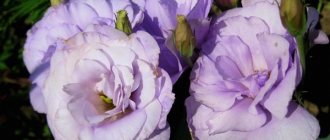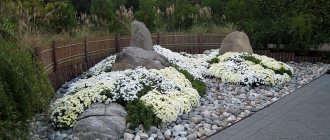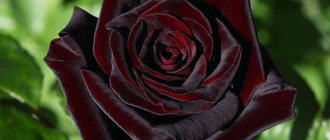It is not for nothing that the rose is called the “queen of the garden”, because its buds are captivating, its aroma is attractive, and its color palette delights. But before you decide to plant it, you need to study all the nuances of growing it. First of all, you need to pay attention to suitable conditions, because not all varieties can take root in a changeable climate. This is exactly how you can describe the weather in the Moscow region. But thanks to the work of breeders, today there are varieties that successfully adapt to such harsh conditions. In addition, it is possible to choose park roses without shelter for the Moscow region, hardy and resistant to many adverse factors.
Park roses are one of the most suitable varieties for growing in central Russia, including in the Moscow region
Criteria for choosing park roses for the Moscow region
There are no special criteria for choosing park roses for the Moscow region; as a rule, these are only purely individual preferences. But any gardener pays attention to the budding of the plant. And the earlier and longer the bush blooms, the more popular the variety. In addition, many take into account versatility, so that the range of shades pleases not only the eye, but also matches the style direction of the garden. No less important are frost and drought resistance, as well as immunity to diseases and pests.
The best park roses for the Moscow region
Unfortunately, not all varieties of prickly beauty are suitable for growing in the Moscow region, where winters are quite harsh and summers are not always warm. Basically, gardeners try to choose species of Canadian and English selection; they are more resistant to temperature changes. But don’t discount French and German hybrids, which are also able to survive a frosty winter.
Leonardo da Vinci
The park rose Leonardo da Vinci is the brainchild of the French breeder Alain Meillan. In the conditions of the Moscow region, it grows very compactly, its size can vary between 0.6-1.5 m. Despite this, the bush is quite dense, with powerful leaves and strong, erect shoots. The flowers are large (7-10 cm in diameter), goblet-shaped, classic in shape. The tone of the petals is soft pink. The aroma is subtle, with notes of fruit.
Attention! Bushes of this variety can easily withstand frosts down to -20 °C; at lower temperatures it is better to cover the rose for the winter.
The Leonardo da Vinci rose is valued for the fact that the decorative appearance of the buds does not suffer from sudden gusts of wind and precipitation
Rose Lions Rose
The rose variety Lions Rose is a creation of the German company Kordes, which is part of the “Fairytale Roses” collection. The bush is medium-sized, reaches a height of up to 90 cm. The shoots are straight, long, with large flowers up to 10 cm in diameter at the ends. The buds are double, when half-opened, they have a creamy-pinkish tint with an apricot core. When fully opened, the flowers acquire a beige color. The aroma is unobtrusive, sweet.
The Lions Rose variety is characterized by abundant and long-lasting (wavy) flowering until frost.
Louis Odier
The park rose Louis Odier was created by the French breeder Jamesin Odier, working at the Bellevue nursery. Later, the rights to distribute the variety were purchased by Margotin (England).
The bush is tall, up to 130 cm, densely leafy and prickly. The rose blooms in waves. Its buds initially resemble a peony; when fully bloomed, they take on a cup-shaped shape. The color is darker pink towards the core and fades towards the edges. The aroma is attractive, with a slight hint of citrus.
Large flowers can appear on clusters of up to five pieces, causing the shoots to bend, creating the impression of a blooming fountain
The best varieties of park roses without shelter for the Moscow region
Despite the unpretentiousness and winter hardiness of the varieties described above, they still require preliminary preparation for winter. But there are also more frost-resistant options for park roses for the Moscow region, photos with names of which are presented below.
Westerland
The park rose Westerland from the German company Kordes is highly resistant to frost, which is important when grown in the Moscow region. It also has good immunity to powdery mildew and black spot.
The bush is tall, reaching up to 2 m. The shoots are flexible and powerful, easily supporting 5-10 buds. The leaves are glossy, light green in color. The buds when closed have a dark orange tint; as they open, their color changes to a lighter, peach color. The flowers are large, 10-11 cm in diameter and have a pleasant rich aroma.
One of the features of the Westerland park rose is its heady, persistent aroma.
Chippendale
The rose variety Chippendale (Chippendale) of German selection belongs to the park variety due to its vigorous growth. The declared height of the bush varies from 70 to 120 cm, while the width reaches up to 100 cm.
Flowering is abundant, wavy. Up to three buds can form on one shoot. The flowers are large, about 12 cm in diameter. Their shape is rounded-ovoid, tapering towards the apex. The colors are interesting, changing as the buds bloom. At first they have a bright orange hue, then the petals fade and acquire a delicate peach color.
Without shelter, the Chippendale park rose can withstand frosts down to - 28 °C
Chinatown
The Chinatown rose variety is also classified as a park variety that does not require shelter when grown in the Moscow region. The bush is tall (185 cm in height) and quickly growing, can reach up to 120 cm in width.
The buds are bright, creamy yellow, with slightly noticeable pink streaks. The shape is goblet-shaped, in full bloom it is cup-shaped, consists of 25-35 densely collected petals. The diameter of the flower varies from 7 to 10 cm. The aroma is rich, fruity.
Park rose Chinatown takes root well in partial shade and tolerates cool summers well.
Park roses for the Moscow region, blooming all season
In addition to frost resistance, the flowering of the shrub is also an important factor. And among the large list of suitable varieties for growing in the Moscow region, it is worth highlighting those that can decorate the site throughout the entire season.
Rosarium Uetersen
The rose variety Rosarium Uetersen, which belongs to the German selection, can be grown in the Moscow region as a park or climbing rose. Throughout the season, its bushes are strewn with large, rich pink buds. Terry flowers are collected several times in large brushes.
Flowering is wavy, where the first wave is the most abundant. The bush is able to bloom until frost, and under favorable conditions, the breaks between waves are almost imperceptible.
Rose flowers Rosarium Jutersen practically do not fade in the sun
Rose Golden Gate
Another variety of park rose that takes root well in the conditions of the Moscow region and pleases with abundant and long-lasting flowering is Golden Gate. It was developed in Germany in 2005 and has already proven itself to be resistant to many adverse factors and unpretentious.
The bush is powerful, tall, capable of reaching up to 3 m in height and 1 m in width. Flowering is long, but with short breaks (there can be up to 3-4 waves per season). The buds are large, lush and have a beautiful yellow color.
In addition to the attractive yellow hue of the buds, the Golden Gate rose delights with its unique aroma with citrus notes
Variety Princess Alexandra of Kent
One of the representatives of Austin roses, Princess Alexandra of Kent, can boast of abundant and repeated flowering throughout the season, even in the most unfavorable conditions, such as in the Moscow region.
The variety is tall, up to 1.5 m in height. The flowers on the stems are collected in clusters of three. The buds are densely double, large, cup-shaped. Their color is soft pink. The aroma when opening is classic, and as it ages, notes of citrus and currant appear.
In addition to almost continuous flowering, the buds of the Princess Alexandra of Kent rose keep their shape perfectly in any weather
Description
Park roses are usually not too tall, but rather spreading shrubs. They bloom throughout the warm season and are distinguished by simply excellent decorative qualities. There are varieties with petals of different shades and sizes, double, semi-double, regular, single and collected in small inflorescences. The foliage of park roses is rich, dark green and very showy. The fruits of these plants are also beautiful - large and bright.
Varieties of Canadian park roses for the Moscow region
Canadian varieties of park roses are quite popular among gardeners in the Moscow region, because they were specially created for cultivation in regions with a changeable and cold climate. And their main advantage is that they can winter without shelter.
Henry Hudson
The Canadian park rose Henry Hudson is more of an experiment than a deliberate result of breeders. Although the variety is considered a side effect of a test for the genetic abilities of the Schneezwerg rose, the plant turned out to be persistent, unpretentious and takes root well in various conditions.
The buds at the beginning of flowering have a pink tone, which fades as they bloom and becomes almost white in the sun, and pale pink in partial shade. The flowers are double, cup-shaped, and when fully opened, yellow stamens can be seen.
Henry Hudson flowers do not shed their petals when they wither, but dry up right on the bush, which requires more frequent pruning
Martin Frobisher
Martin Frobisher is a park rose that survives well in the climatic conditions of central Russia (in the Moscow region). The plant is powerful, medium-sized, growing up to 120 cm wide.
The bush blooms with pale pink buds. At the same time, the color of the outer petals is much lighter than the central ones. The flowers are numerous, small, 5-6 cm in diameter, which form a raceme of 3-5 pieces. Roses have a delicate, classic scent wafting throughout the park.
The small flowers of the Martin Frobisher rose quickly fade, but new buds immediately appear to replace them.
Variety Quadra
Quadra rose is the result of painstaking work of breeders. After all, they were required to create a variety resistant to the most severe frosts. As a result, this plant can easily boast of survival even at -40 °C.
The flowers are very bright and beautiful, red-crimson in color. The brush can consist of 3-4 buds, the diameter of which varies up to 11 cm. Their shape is peony-shaped, the petals open gradually until the core is exposed.
Advice! When grown in gardens in the Moscow region, the Quadra rose requires the formation of a crown, since the bush grows very quickly in width.
The powerful root system of the Quadro rose allows it to withstand not only severe frosts, but also dry weather
Queen of Sweden
Another Austin rose. It is considered one of the most beautiful in his collection. The flowers are very delicate and resemble water lilies. The petals are painted in a pink tint that is pleasant to the eye. It even feels like they are glowing from within.
Year of breeding: 2004. The breeder crossed the famous “Charlotte” scrub and an unnamed seedling. The rose bush is upright, branched and compact. It can reach a height of 120 centimeters. The shoots are smooth and powerful.
Gardeners like that this crop is undemanding to care, it is hardy and can withstand frosts down to -23 degrees. It is usually used for landscaping parks, squares and personal plots. The bushes look wonderful both in single and group plantings. Roses are also often grown for cutting. It looks perfect in bouquets.
Flowering is abundant and repeated, it lasts from June until autumn. Flowers are moderate in size, double, symmetrical. Watching them unfold is very interesting - it is a beautiful process. Their smell is light and unobtrusive. They stay on the bush for about a week, and even less in rainy weather.
In the spring, it will be necessary to carry out sanitary pruning of the bush, removing damaged and weak shoots, as well as those directed into the bush. Other branches are reduced by a third. For more abundant flowering in the summer, it is recommended to get rid of wilted flowers so that new ones can appear.
Despite the fact that the variety is considered frost-resistant, shelter is still necessary in regions with harsh winters. In the fall, you definitely need to make a radical look. It is also worth paying special attention to treatment against pests, because the plant’s resistance to them leaves much to be desired.
The variety has high decorative properties, so you can use it to decorate clubs, hedges, and so on. Gardeners are very happy with it.
Varieties of English park roses
English roses are in no way inferior in beauty and unpretentiousness to varieties of Canadian selection, but their resistance to frost is not as strong. Often these plants require proper autumn preparation in order to survive the winter of the Moscow region.
Fisherman's Friend
Rose Fisherman's Friend is one of James Austin's best creations. During flowering, the bush is very beautiful, because it is covered with densely double buds with a diameter of up to 12 cm. The color of the buds depends on many factors, and it can be from garnet to dark crimson.
The bush itself is compact, reaching up to 1.2 m in height and only 80 cm in width. The shoots are erect, strong, with a large number of thorns. During flowering, the branches bend under the weight of the buds, visually giving the bush a spherical shape.
Despite its good tolerance to low temperatures, the Fisherman's Friend rose is not resistant to diseases
Charles Austin
Park rose Charles Austin is also great for growing in the Moscow region. The plant itself is compact, densely leafy, with erect, strong shoots. The height of the bush does not exceed 1.5 m. The leaves are large and against their background the densely double pale orange or apricot flowers look great. Their aroma is delicate and intensifies as the buds bloom.
Attention! Although the variety is a repeat flowering variety, the second wave of flowering may not occur, since the plant requires good care (proper watering, fertilizing).
Strong shoots firmly hold the buds even at the peak of flowering of the bush, so the Charles Austin rose does not require support or tying
Golden Celebration
The park rose Golden Celebration is characterized by powerful, slightly drooping shoots. The bush itself is spreading and tall, can reach up to 1.5 m in height and width. Moderate amount of green mass. The leaves are dense, hard, with a glossy surface of rich color. There are few thorns.
The flowers are small, collected in 3-5 pieces in racemes. The aroma is pronounced, sweetish, with notes of fruit.
The color of Golden Celebration roses is very beautiful, golden-copper, and their diameter is up to 14 cm
Diseases and pests
Hardy Canadians are not prone to disease, but black spot still sometimes affects them. To prevent this from happening, during the growing season the plants are sprayed with copper-containing preparations. If the leaves still become stained, it is worth spraying the roses with Skor. Affected foliage must be burned in the fall.
Insecticidal preparations such as Actellik and Fufanon will help against insects such as aphids, thrips or mites. The main thing is to carefully follow the standards specified in the instructions for use.
Rose lovers who do not have the time or desire to tinker a lot with their pets should definitely take a closer look at the varieties of Canadian selection. Hardy and unpretentious flowers will delight with their beauty throughout the whole summer, without causing unnecessary trouble.
0 0 votes
Article rating
Planting and caring for park roses in the Moscow region
Despite the changeable weather in the Moscow region, roses must be planted at a certain time. Moreover, subsequent care is practically no different from growing this garden plant in other regions. You just need to follow some rules.
Landing dates
In order for the rose bush to take root and begin to develop, it is necessary to choose the right planting time. The most favorable time is considered to be the end of spring, when the threat of frost has completely passed. In the Moscow region, this period falls in mid-May. It is also possible to plant seedlings in the fall, but no later than six weeks before the onset of cold weather. Such terms will allow the root system to better take root in the new place and grow stronger.
Requirements for place and soil
How well it will take root also depends on the correct choice of place for the rose. This shrub does not like through winds and does not tolerate stagnant water. Therefore, you should choose a site on a hill near large trees or buildings.
Attention! The “lace” shadow from the tree crowns will provide a more saturated color to the flowers, as they will fade less in the sun.
The soil must be fertile. If there are not enough nutrients in it, then you need to pre-prepare the soil. To do this, mix the soil with a bucket of clay, two buckets of compost, as well as two glasses of bone meal and wood ash. It is advisable to add half a glass of complex mineral fertilizers and superphosphate to the resulting mixture. It is prepared immediately before planting, using soil pulled from the hole.
How to plant correctly
The landing algorithm is quite simple:
- The rose seedling is carefully inspected, removing weak and rotten branches of the roots.
- Expanded clay is placed at the bottom of a hole previously dug to a size of 50 by 50 cm. It is necessary to create a drainage layer. A sand cushion is poured on top.
- Lower the seedling into the hole and straighten the roots. And so that they do not come into contact with the mixed fertilizers in the soil, they are also sprinkled with sand on top.
- Before pouring the soil mixture, be sure to ensure that the grafting site is located 5-7 cm below ground level, this will allow the seedling to survive the first winter more easily.
- Then fill the soil, compact it and water it abundantly.
Aftercare
Care after planting consists of timely watering. It is carried out in 1-2 days depending on the weather. On cloudy days, the amount of watering can be reduced.
The rose does not need fertilizing for the first 2-3 years, but in the fourth year of life it is recommended to apply fertilizers twice a season (spring and autumn).
Pruning and covering of park roses will depend entirely on the characteristics of the variety.
How to properly care
Canadian roses are not particularly demanding of care and are not very capricious, but in order for the plant to bloom beautifully and gracefully, it is best to follow these steps:
- Eliminate dead, frozen, diseased shoots in early spring and late fall.
- Fertilizing with nitrogen fertilizers in the spring, and in the summer with phosphorus-potassium fertilizers, when the first flowering period ends.
- In hot and particularly dry times, the plant needs abundant watering, as well as special fertilizing. At other times of the year, moderate fertilizer should be applied, strictly at the root of the plant.
- Carefully ensure that the soil becomes more moist.
- Pruning in spring should be done once every few years.











